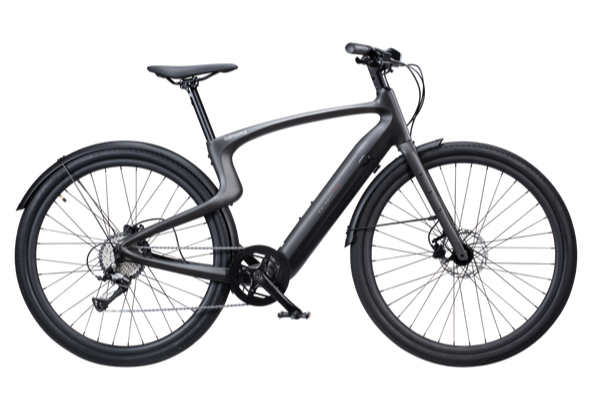The electric bicycle world is evolving as outdoor enthusiasts and weekend warriors more and more are seeking more aggressive, nimble rides for their pursuits. Where old-school e-bikes have focused on power at the expense of weight, today’s e-adventurer is looking for the perfect combination of power and agility. This delicate balance is a special challenge for manufacturers, who are trying to combine robust features with a long battery life, while reducing weight considerably.
For adventure, off-road and gravel riders who take on everything from mountain trails to urban green space and that need a responsive yet rugged e-bike, that’s more of an issue than ever. They need a machine that can climb technical sections, and negotiate tight switchbacks without breaking a sweat, but can do so without being a bulky oversized monster that makes manhandling and storing a chore. Thanks to advances in advanced materials, cutting-edge battery technology and refining of hyper-efficient data-crunching for adaptive terrain response systems, a new generation of super light and capable e-bikes has completely changed the way we conquer the outdoors.
The Evolution of Electric Bikes: Why Lightweight Matters
Electric bikes have come a long way since their inception, with weight reduction a key area of focus for modern designs. Early e-bikes could weigh in at 50-60 pounds, a size that can be both unwieldy and cumbersome to carry. This weight disadvantage seriously skewed their attraction to adventurers requiring nimble, easy to handle, outdoor mobility.
The trend of lighter e-bikes has transformed the riding experience in a number of fortuitous ways. Less weight means better maneuverability on technical trails, better power-to-weight when hitting bottomless stashes, and easier turning in tight trees and bumps. Heavier bikes, the sort of electric bikes with bigger batteries and motors and other electronic doodads, demand more from the rider and keeping pace with a friend who’s content with a 250-watt push requires more effort as well. Lighter bikes, by contrast (and when the motor assistance isn’t activated), call for less human oomph from the rider, which also prolongs the ride and staves off fatigue. It is also efficient in terms of battery life, because (all else being equal) lighter frames require less energy to move, and therefore grant you a longer range.
Weight can be very important to off-road terrain management. Where lighter e-bikes really shine is in scenarios that require frequent changes of direction, hopping over obstacles and carrying over unrideable sections. The lower mass also translates to less momentum on descents, which is considered safer and allows for more control. In this case, ultra-lightweight modern skis have managed to do this, focusing on adding strength in high-stress areas, and removing as much material as possible in areas where it doesn’t add anything.
Key Features of Top-Tier Lightweight E-Bikes
Durable Frame Materials for Adventure Riding
Lightweight modern e-bikes use sophisticated frame technologies that include hydroformed tubes to balance durability with desired low weight while offering superior aluminum, as well as svelte carbon fiber. And if that wasn’t enough, full carbon fiber premium frames take weight savings to the next level with layering methods that soak up bumps and vibrations without sacrificing an ounce of strength for high-intensity off-road workouts.
High-Capacity Batteries Without Added Bulk
Precisely because of that revolutionary lithium-ion battery technology, energy density has improved dramatically, letting automakers pack more range into slinkier bodies. These high-capacity power packs house the battery elements in a ‘smart’ frame downtube, where it is protected and removed with ease. Intelligent power management systems provide optimum energy, balancing power and efficiency while on the go for improved range and battery life.
Eco-Friendly Performance Meets Advanced Navigation
Many major manufacturers are now focusing on environmentally-friendly production, recycling and energy-efficient manufacturing. They are designed with biodegradable elements, where feasible, and recyclable battery systems. Advanced navigation features that are built in include full mapping with detailed trails, and on-device navigation options plus notifications as well as new preloaded Strava Live Segments. These networks also work with phone apps to offer full ride references and traceability, giving adventurers the freedom to explore confidently while minimizing their footprint.
Solving Adventure Enthusiasts’ Core Needs
Conquering Rough Terrains with Durability
State of the art suspension: State of the art suspension systems by RockShox and Suntour feature refined air springs that are lighter and more supple than coil, with additional adjustability for damping to adapt to any terrain. Customize your ride whether you are a masher or a spinner, so your suspension can be as stiff as you are. Choose how you ride on the fly to optimize your ride. These are complemented by tubeless-ready wheels and flexibility on tire compounds to give excellent grip whichever the terrain. Multiple compression settings allow riders to fine tune their ride to what they efficiency to the trail all the while not having to sacrifice the added weight of adjustability.
Maximizing Ride Duration with Battery Efficiency
Contemporary e-bikes are made of very dense and heavy components that may not be conveniently removed to change out the power cells for a longer adventure. These power units are modular, so they maintain waterproof connections, but can be accessed by riders to swap out and change in less than 5 minutes. Compatible solar charging solutions plug right into the bike’s power management system and have thin, flexible panels that can be strapped to a backpack or the bike frame itself. These forms of charging offer renewable sources of energy for rest stops which would have otherwise been spent fueling up, and they help the bike remain lightweight despite the increase in range. Smart power distribution algorithms dynamically regulate motor assistance according to remaining battery life, terrain difficulty, and user input, to deliver best in-class performance throughout longer distance urban adventures.
Top Lightweight E-Bike Models for 2024
Today’s lightweight electric bikes demonstrate outstanding engineering feats in natural-feeling light weight, while retaining the same performance and range. Newer manufacturers, such as Urtopia, have unveiled sub-35 pound models with similar range of 40-60 miles per charge. Centre of frame motors are also more efficient than hub motors on challenging terrain and maintain ideal weight distribution.
Adventure-oriented models have robust frames that are able to handle heavy off-road use and are kept light for overall weight mass. This testosterone of tubing has quick-release wheels, tool-free adjustability, and drop-out modular battery systems which make for ease of maintenance and ease of upgrade. At the premium level, ultra-compact, weatherproof display units bring high-end navigation to your cockpit, with discreet dot matrix screens offering up all the essential trail info and battery management data, at almost no extra weight.
Accessibility has also improved at the entry level, with aluminum frames and efficient hub motors that provide good off-road power. These workhorse models also are durable with reinforced parts and sealed electronic systems for those who want to go on long, outdoor adventures while experiencing all that e-bikes have to offer. More premium carbon fiber models push the limits further, with built-in lighting systems, wireless connectivity, and power modes that are programmable to your preferences, all before you even get to the 30 pounds and sub-$6,000 carbon gem.
Embracing the Future of Lightweight E-Bikes
Light Electric Vehicles are a giant leap forward in outdoor adventure technology. These revolutionary machines have taken the guts of a Berm spec machine and transformed them, giving adventure riders a fantastic combination of agility, while retaining the durability and power of the original machines. Thanks to advanced materials, smart power management, and terrain-tuned features, today’s e-bikes are priced to perform like never before, while remaining lighter than any competing e-bike in its class.
If you’re a thrill seeker that wants to pedal through the backcountry, modern lightweight e-bikes provide the ideal balance of ability with agility. More camera stability and a convenient grip so organic adventures become part of the moment. For riders looking for a lightest electric bicycle, they’ll want to carefully consider how much and what type of terrain they’ll be riding, how far they want to go and what type of riding, before finding the e-bike that best suits their needs. As the outdoor industry pushes onward, these are the efficient machines leading the way toward sustainable outdoor play – and we can’t wait to see what the future holds in store.



































